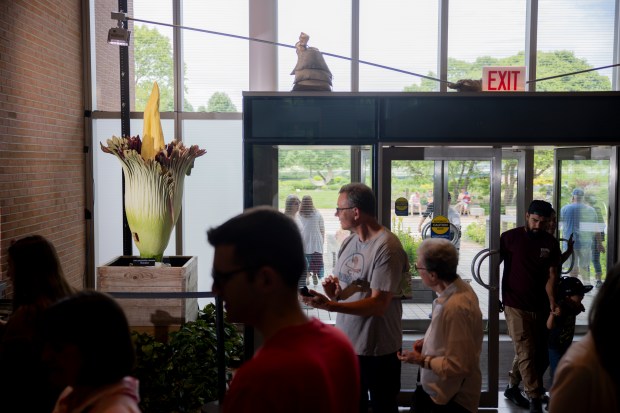Tony Holland gawked at the sprawling flower, which jutted more than 6 feet above him. Its distinct, rancid odor cut through the air, like rotting flesh. It was Holland’s dream come true.
“Just to be able to check this off my bucket list is huge,” Holland, 36, said. “It’s amazing. Absolutely amazing.”
The rare titan arum — fittingly dubbed a corpse flower — is on display and in bloom at the Chicago Botanic Garden in Glencoe. The flowering structures, known as the largest unbranched inflorescence in the word, are exceedingly rare. It’s a sight to see — and, well, smell.
The plant emits the rotten stench to attract its natural pollinators, carrion beetles and flesh flies. Amid a crowd of curious visitors, 5-year-old Sally Uttech crinkled her nose.
“It smells bad,” she muttered.
The Botanic Garden has housed titan arums since 2003, and now nurtures 18 of the endangered species. They’re native to rugged rainforests on Sumatra, an Indonesian island along the equator. Most of the remaining plants are cultivated inside gardens around the world.
It can take more than a decade for a titan arum to develop before its first bloom. Even then, the cycle is unpredictable. Scientists are often unsure if new growth is a leaf or a flower bud, which usually emerges every three to four years. For Plant Production Manager Tim Pollak, it adds to the excitement.
“We’re certainly proud of the fact that we’re able to get them into bloom in such a successful way,” Pollak said, who tends to the plants year-round. “Knowing that it is the world’s largest inflorescence is breathtaking,” Pollak said.
The titan arum currently in bloom for the third time, named Sumatra, last flowered in 2017. A second flower, Spike, is set to bloom for the fourth time in the coming week.
When a bud emerges, the plant grows 5 to 6 inches per day for about two weeks, with the spiky spadix rising above the spathe. Finally, the growth slows, the spathe unfurls, and the plant blasts a foul-smelling odor over an hourslong period. The plant turns a maroon, meat-colored hue to attract pollinators.
In years when the flower isn’t in bloom, it sprouts a massive leaf, which stretches up to 15 feet in the air.
The growth of more corpse flowers is largely a collaborative effort with other gardens around the country. The Botanic Garden freezes and ships pollen so that the titan arums can reproduce with other members of the species.
“We’re acting as a pollen bank with other facilities,” Pollak said. “The botanic garden world is very cooperative, in the sense that we need pollen, you need pollen, we’re willing to share it.”
Dozens huddled around the two titan arums on a recent morning, which sat inside wooden planters. Many visitors took photos beside them. Others dared to whiff the plant as they approached.
Holland drove three hours from the Quad Cities with his family just to catch a glimpse. He first heard about the elusive plant 15 years ago. When he heard that two at the Botanic Garden were set to bloom, he closely monitored them online.
“I told my boss, ‘When I get the alert, I’m gone. I’m going to disappear for 24 hours or so,’” Holland said with a laugh. “My wife texted me yesterday that Sumatra opened, and I’m like, ‘We’re going first thing in the morning.’”
Travis VanZuiden, 37, and Veronica Spriggs, 38, decided to drive three hours from Iowa just to catch a glimpse of the plant. It lived up to their expectations.
“They’re big, they’re rare, they’re unusual,” VanZuiden said as he stared. “It doesn’t even look real.”
The couple said the smell wasn’t as bad as they thought. Its sheer size seemed to distract from the odor, they said.
“He’s been talking about this for years, and I was like, ‘Well, okay,’” Spriggs said. “But seeing it now, I understand. It’s very cool.”



